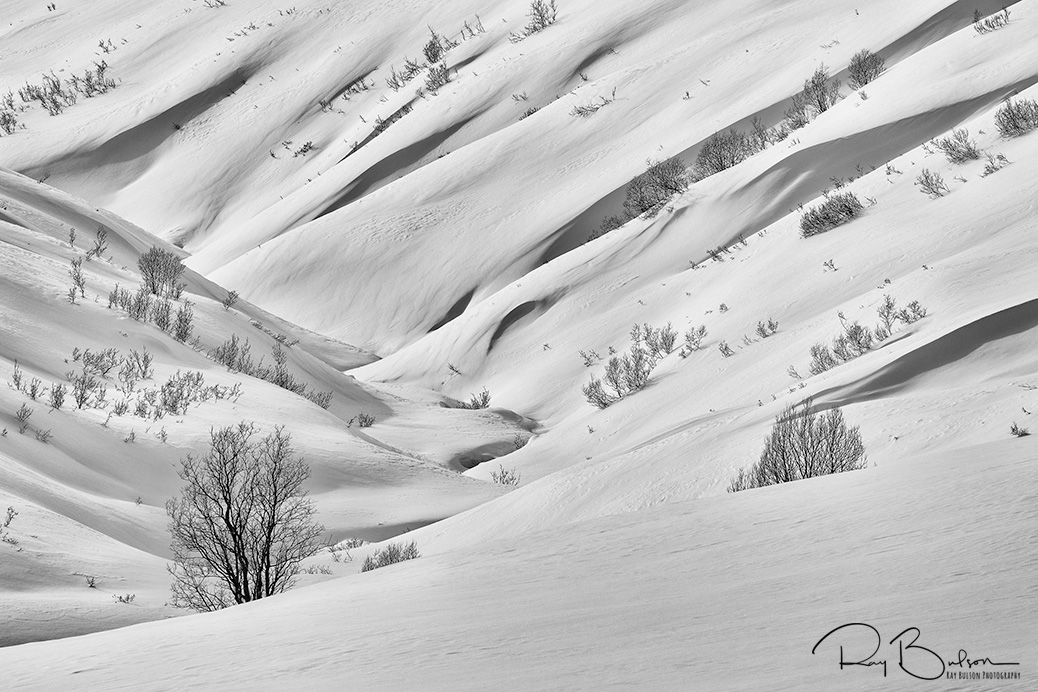
Snow blanketing the Talkeetna Mountains at Hatcher Pass creates flowing shapes in late winter.
Line is the most basic of design elements in composition. You don’t need to study art to know about lines; presented with paper and crayon a toddler instinctively draws lines. In photography, light is essential to a good photograph, but so is the absence of light. As Syl Arena, a Canon speedlight expert teaches, “…light enables you to see an object, shadows enable you to see its depth and texture.” In the ambient light of the outdoors, directional lighting from the sun, especially side-lighting, produces shadows. It is the basis for the concept of chiaroscuro, Italian for light-dark, that was used extensively by Renaissance painters. Combine line with shadow in a landscape and a composition worthy of a photograph emerges.
In late winter, before the melting of breakup starts, the ground is usually covered by the deepest amount of snow. Many storms have come and gone and the snow is sculpted by the winds. The alpine areas of Hatcher Pass offer some of the deepest snows locally and are easily accessible by car. I headed there on a partly sunny day in mid-March looking for the lines of deep snow. Much of the morning was spent around the Little Susitna River. Its path through deep snow and boulders creates interesting undulating shapes – at least that is what I had captured in years past. But nothing really resonated with me until I was almost ready to leave. From the side of the road close to the lodge I saw the scene. With such a profusion of lines created by drifting snow I had to photograph it!
With one of my favorite lens, Canon’s 100-400 f/4.5-5.6 L IS II, I tried various focal lengths and compositions. An image made at about 150 mm made a nice “wide” composition that included more trees in the foreground and lines of snow drifts. But I wanted something tighter and “cleaner” so I shifted my perspective and zoomed in. I worked the scene taking several photos. This composition at 300 mm is my favorite.
Lines strongly affect the movement of the viewer’s eyes through a photograph. In one of Ansel Adams’ iconic landscapes, The Tetons and the Snake River, he used the S-curve of the river and light to draw in the eyes of the viewer. He knew the longer you had the viewer’s attention the more his art could be conveyed and appreciated. In the Hatcher Pass scene, the larger of the two trees in the lower left draws the viewer’s eyes because it interrupts the starkness of the landscape in the foreground. From there the viewer can follow the lead of the mostly straight line of the foreground ridge to jump off to the dominant, jagged zig-zag line of the drainage gully. This gully is carved by snow melt in the spring and summer. Along the path up the gully lines shoot off to the left and right like branches of a tree. These graceful, flowing lines shaped by the ridges and wind are visual paths begging to be explored. They reach nearly every part of the frame except for the lower right.
The RAW file was originally taken in color. However, it was too flat and the lines lost their prominence. Because the lines and light were the subject and not the color, I knew that I needed to convert this to a black and white image. Using Nik’s Silver Efex Pro, the black and white rendering brings out the contrast of the shadows from the sun that was out of the frame in the upper left. Now the full depth of the snow drifts and their curves are emphasized and the landscape becomes more three-dimensional. The lines to the right are like strokes of a paintbrush, with varying thicknesses. The light of the sun seems to glow in the gully and the texture of the snow is revealed. For me the landscape comes alive.
Our binocular vision gives shape, form, and depth to the natural landscape. The challenge for the photographer is to convey this on a two-dimensional media. Fortunately, lines, light, and shadow can be used as powerful artistic tools to distill a complex scene into a simple abstract that becomes a visual journey.


